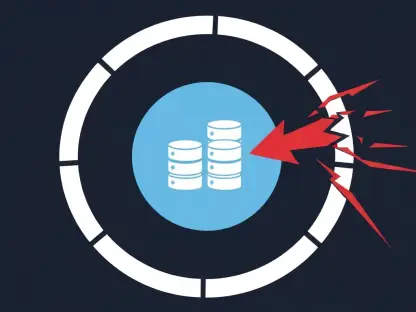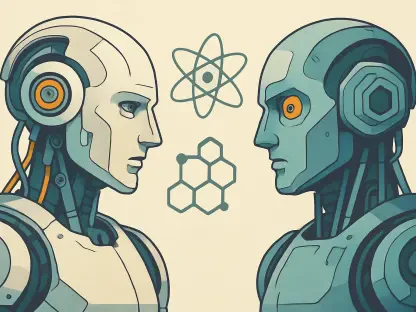The confluence of cloud technology and computational chemistry heralds a new era of accelerated scientific discoveries. Through a groundbreaking collaboration between the Department of Energy (DOE) and Microsoft, the once formidable computational challenges of chemistry are becoming more accessible and efficient, propelling advancements across various scientific fields. The initiative, which embodies the partnership’s combined expertise, promises to revolutionize the way computational chemistry is conducted by harnessing the scalability and sustainability of cloud technology.
In recent years, scientific research has increasingly relied on high-performance computing facilities to tackle complexity. However, these traditional solutions often fall short in terms of versatility and accessibility for a broader audience. A diverse team from Pacific Northwest National Laboratory (PNNL), other national laboratories, universities, and Microsoft seeks to shift the landscape by creating a more dynamic and sustainable ecosystem for scientific computing. This ecosystem is designed to evolve continually alongside technological advancements, ensuring its relevance for years to come.
The Power of “Compute as a Service”
A pivotal concept in this transformative effort is “Compute as a Service.” Leading the charge, PNNL computational chemist Karol Kowalski explains the advantages of integrating software services with cloud computing resources. Bundling these resources offers a flexible and efficient alternative to traditional high-performance computing systems. This paradigm shift, extensively outlined in a paper published in “The Journal of Chemical Physics,” presents a complementary mechanism for solving complex scientific problems more rapidly. Kowalski and his team recognize that transitioning both legacy algorithms, such as PNNL’s NWChem software, and new software optimized for advanced GPU architectures into the cloud can lead to significant gains in speed and efficiency.
Researchers have observed notable improvements in computational workflows. Tasks that previously required months can now be completed in mere days, drastically quickening the pace of scientific discovery. This rapid processing capability is essential for initiatives like TEC4, which stands for “Transferring Exascale Computational Chemistry to Cloud Computing Environment and Emerging Hardware Technologies.” This initiative epitomizes the computational chemistry community’s collective pursuit of keeping pace with continuous technological and scientific advancements.
The notion of “Compute as a Service” aligns perfectly with the shifting demands of modern scientific research. By leveraging cloud computing, researchers can access and utilize computing power on an as-needed basis, paying for only what’s consumed. This model eliminates the prohibitively high upfront costs traditionally associated with building and maintaining high-performance computing infrastructure. Additionally, the flexibility of cloud computing allows for the seamless scaling of resources to meet the demands of diverse scientific missions.
Cloud Technology Beyond Data Storage
The article underscores cloud technology’s exponential growth beyond mere data storage as it becomes an essential tool for computational chemistry. Industries like finance and pharmaceuticals are already capitalizing on cloud computing, demonstrating its broad applicability. The current initiative seeks to transfer intensive computational algorithms to the cloud for applications in critical fields, including industrial chemical formulations, advanced polymers, and surface coatings. One striking demonstration of cloud computing’s potential is its use in studying the molecular dynamics of chemical reactions.
For instance, Microsoft Azure is employed to investigate the breakdown of persistent pollutants like perfluorooctanoic acid. Such simulations demand substantial computational resources, showcasing the practical utility of cloud computing in forming real-world solutions, such as environmental remediation strategies. This shift to cloud-based resources represents a broader adoption trend across various industries, which are starting to leverage cloud technology’s vast potential to streamline processes and enhance innovation.
Industries have long recognized the potential of cloud computing, but its practical applications in computational chemistry are particularly transformative. For example, industries focused on chemical synthesis and environmental sciences can benefit considerably by employing sophisticated simulations and modeling directly from the cloud. This capability not only accelerates research timelines but also enables more accurate and reproducible scientific results. As such, the initiative represents a major leap forward in the use of cloud computing for solving real-world scientific challenges.
Building a Scalable and Sustainable Computational Ecosystem
The project’s most enduring legacy could be the creation of a sustainable computational ecosystem, a prominent theme highlighted throughout the initiative. This system promises a tiered approach that allows users to select from various layers of computational resources based on their specific needs. By paying only for the resources they use, researchers and industries alike can achieve significant cost savings. Kowalski envisions an ecosystem accommodating a broad spectrum of computational tasks, ranging from low to high-tier jobs, leveraging GPU-based computing extensively employed in AI and machine learning applications.
Extending beyond immediate computational needs, the initiative emphasizes expanding the ecosystem to include new collaborators. The goal is to build a thriving community of scientists adept at using advanced computational tools. Educational programs, such as the new course at the University of Texas at El Paso, developed in collaboration with Central Michigan University and PNNL, aim to train the next generation of computational chemists. These programs are crucial for fostering the skills necessary to utilize cloud-based resources effectively, ensuring that the scientific community remains at the forefront of innovation.
The proposed ecosystem’s tiered structure is designed to offer unparalleled flexibility and scalability. This approach ensures that researchers can optimize their computational resource usage, aligning with their specific scientific objectives. Moreover, the integration of GPU-based computing signifies a noteworthy advancement, as it leverages the inherent advantages of parallel processing capabilities, particularly applicable in AI and machine learning. The comprehensive nature of this initiative, encompassing education, collaboration, and cutting-edge technology, sets it apart as a forward-thinking model for scientific research infrastructure.
Collaborations for Advanced Computational Chemistry
Collaborative efforts form another cornerstone of this initiative. Microsoft’s Azure Quantum Elements platform, led by product leader Nathan Baker, leverages modern AI and HPC tools to advance the field of computational chemistry. Over the last decade, computational chemistry has played a crucial role in resolving complex scientific challenges, guiding experiments, and making accurate predictions. Leveraging these advanced tools ensures that computational chemistry continues to make substantial contributions to a range of scientific endeavors.
The TEC4 initiative serves as a testament to the necessity of adaptive software capable of meeting evolving hardware capabilities and scientific demands. By driving advancements in software development and incorporating cutting-edge computer science efforts, quantum computing, and AI, the initiative aims to unlock new avenues in scientific research. The heightened focus on collaboration ensures that these technological advances are comprehensively integrated into the research landscape, providing researchers with the tools they need to push the boundaries of what is possible.
Microsoft’s role in this collaboration highlights the importance of bringing together diverse expertise and resources to tackle scientific challenges. By combining cloud computing capabilities with advanced AI and HPC tools, the initiative is well-equipped to address the multifaceted problems that arise in the realm of computational chemistry. Furthermore, the integration of quantum computing signifies a forward-looking approach, as it promises to revolutionize the way complex computations are performed, potentially leading to breakthroughs that were previously unattainable.
Financial and Institutional Support
The initiative has garnered substantial financial and institutional support, highlighted by the backing of TEC4. Funding sources include the DOE Office of Science, Basic Energy Sciences program, and the Division of Chemical Sciences, Geosciences, and Biosciences. Additional support comes from the Department of Defense Strategic Environmental Research and Development Program and internal investments by PNNL. This robust financial backing is critical for ensuring the continued advancement and success of the initiative.
Development of key algorithms, such as NWChem, NWChemEx, and Arrows, has utilized resources from prominent research facilities including the Environmental Molecular Sciences Laboratory and the National Energy Research Scientific Computing Center. The contributions of these institutions have been instrumental in propelling the initiative forward, providing the necessary computational power and expertise to achieve its ambitious goals. The extensive support network underscores the importance of a collaborative approach in addressing the complex challenges of computational chemistry.
Moreover, many of the initiative’s contributors are part of the PNNL Computational and Theoretical Chemistry Institute (CTCI). This institute strives to accelerate the evolution of molecular modeling capabilities by integrating chemistry software with advanced computer science, quantum computing, and data science tools. By bringing together these diverse disciplines, CTCI is paving the way for future scientific breakthroughs. The synergy between these various elements highlights the interdisciplinary nature of the initiative, ensuring that it remains at the cutting edge of scientific research.
A Quantum Leap Forward in Scientific Research
The merging of cloud technology with computational chemistry marks the beginning of a transformative era in scientific discovery. A pioneering collaboration between the Department of Energy (DOE) and Microsoft is making the traditionally daunting computational challenges in chemistry more accessible and efficient. This initiative aims to revolutionize computational chemistry by leveraging the scalability and sustainability of cloud technology, driving significant advancements in numerous scientific disciplines.
In recent years, scientific research has leaned heavily on high-performance computing to manage complexity. Traditional computing methods, however, often lack the versatility and accessibility needed for a wider audience. A diverse team from Pacific Northwest National Laboratory (PNNL), other national labs, universities, and Microsoft is working to change this by developing a more dynamic and sustainable ecosystem for scientific computing. This new ecosystem is continually updated to integrate the latest technological advancements, ensuring its continued relevance and effectiveness well into the future.









